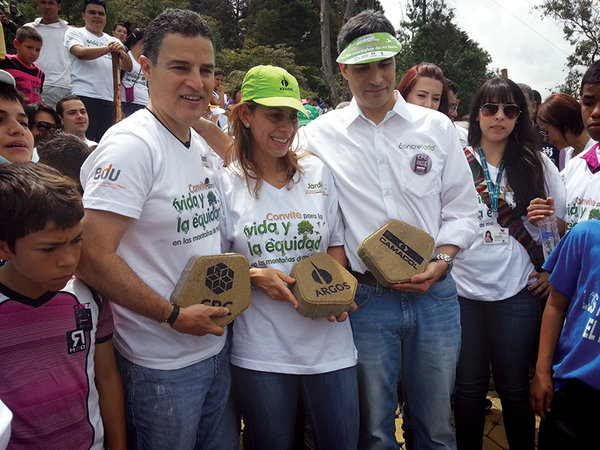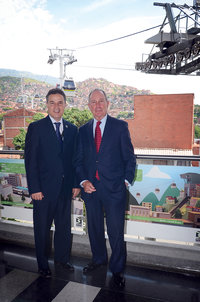
Interview with Aníbal Gaviria Correa, Mayor of Medellin, Colombia
02 July 2014
by Richard Forster
Prior to hosting UN-Habitat’s 7th World Urban Forum in April, Jonathan Andrews spoke with Aníbal Gaviria Correa about the transformation of his city and how hosting the Forum will signify his city’s reintegration into the global community
Medellin has become an example of how urban transformation based on good architecture can reshape the mentality of its inhabitants. Is it just a simple case of designing and erecting nice buildings?
No, architecture is a cultural response to human development; it is the community that evolves. The true basis of this evolution is merely reflected in physical construction. This is possible through the process that we call pedagogical urbanism. The basis is to understand architecture as a process that includes citizen participation through training, engagement and education.
The Unidades de Vida Articulada [newly designed libraries, schools, parks] are a perfect example, built from the thoughts of citizens, which the architect then interprets and formulates into a structure.
Medellin is rightly known as moving from fear to hope. What can your city’s experience in transforming public safety teach other cities?
Our path was a demanding and supportive one, and today it is an experience that we share, to pursue a better life for all. Our commitment to the cities of the world is to build paths for equality and life. We have therefore developed and shared the ‘Medellin Charter’ as an inspirational method for cities around the world to follow.
The effort of our entire community has defined the progress we have made in the past two decades. This has been a social and political construction that is worth emulating by other cities. It has led to long-term city projects that along with some adjustments at each stage, has provided us with the necessary continuity in equality, education and accessibility for all. It has served as an experience we can and want to share with the world.
How much has the use of sustainable transport, including the city’s pioneering Metrocable, or gondolas, helped to change Medellin?
It has been essential, not just as an infrastructure or transport project but also as a tool for social inclusion and integration. This is based on a society that seeks greater equality in all areas of a city and ensuring the right to a city. We see the Metrocable as more than just a means of transport. It has helped build a community, and provide greater access to the city, allowing many people to move from being simply residents, to being part of our citizenry with rights and duties.

Will more Metrocable lines be added to the existing three?
Our city has a huge challenge in the development of sustainable transport. We are planning to expand the iconic Metrocables and also the Metroplus BRT network to increase our credentials as a sustainable and equitable city.
Both metropolitan plans of the municipalities of Valle de Aburrá and companies like Metro and Metroplus, include projects that form a substantial part of the Territorial Ordinance Plan that we are currently developing.
A year ago Medellin won the Wall Street Journal / Citi ‘Innovative City of the Year’ award, beating other finalists Tel Aviv and New York. How is the city ensuring it remains in the top tier of innovative cities?
Our approach is to improve human development and citizens’ lives to close the inequality gap that has shaped our city’s past. We have learned to use tools such as infrastructure, urban planning and architecture to find new ways to better people’s lives in the city. We will, therefore, always seek more innovation and knowledge to improve society.
We are doing this through the promotion of ‘Medellinnovation District’, which works with RutaN [an innovation promotion organisation set-up by the City Council and other government agencies], to promote innovative technologies and companies that improve urban development. The District will place Medellin among the global community of cities. For this, we are working with the support of MIT SenseableLab, Barcelona Activa, District 22@, ACI Medellin and the research community from universities, along with other supporters.
What has been the biggest challenge in your first two years as mayor?
Engaging our entire society in the challenge of walking together along the path to greater equality, with awareness and commitment. We are moving forward in a very positive direction but we still have much to do.

A key concern for cities is how to finance improvements and new infrastructure. In what ways is Medellin tackling this problem in terms of attracting private sector funding?
With rigour and ensuring transparency in all stages with public resources. We seek executive efficiency of social investment and honour the social meaning of public administration. The Territorial Ordinance Plan, which is currently in its final consultation stages, will guide the development of our city. It will set out the mid and long-term planning, so that large-scale projects benefit all, in which we will promote dialogue with the public and private sector.
The Medellin River Park is a US$1 billion project to rejuvenate the river and recover its place in the city. Are you learning from other cities that have also radically transformed their rivers?
We are always learning from other cities. We strongly believe in cooperation and that is why we participate in networks such as CIDEU [Ibero-American Centre for Strategic Urban Development], host forums and conferences such as the 7th World Urban Forum, and look to begin and manage new relationships.
The River Park project, Parques del Río, is very innovative for our city, and has the support of several cities worldwide. Cooperation is already a hallmark of Medellin, and proof of this is our links as a city, and mine as president of CIDEU, and agreements such as those with the city of Barcelona and the French Development Agency among others.
At the time of going to press you are due to host the 7th World Urban Forum this month under the theme of ‘Urban Equity in Development–Cities for Life’. How has, and is, Medellin ensuring greater equality for all its residents?
We work daily, with the highest priority in mind, to build a city for life without inequalities. This is our biggest goal. Every government action is focused on life and equality.
What are your expectations for the Forum? Is it a good investment for the city?
It is an extremely important and strategic investment because it symbolises the definitive reintegration of our society within the global community. We will capitalise on the social, economic and political outcomes that this Forum will give to Medellin, Colombia, and the world. Medellin will make a lasting impression with world visitors as a reference for ideas regarding cities.
A key legacy will be the ‘Hall Medellín’. This pavilion, in the months following the forum, will be the place where citizens will come to discuss, and provide ideas on our city’s attributes and challenges to ensure we continue to build a shared city.







